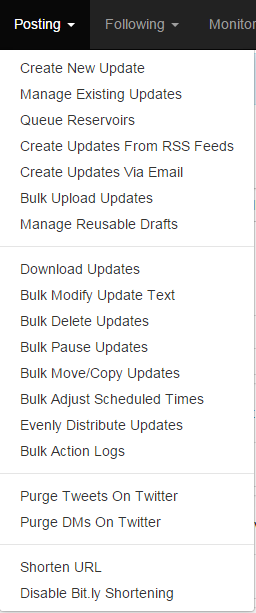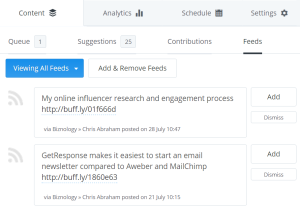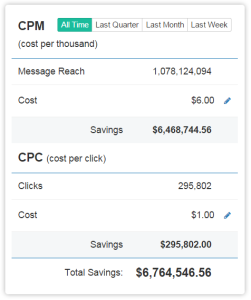 Even of you have enough money to hire an entire social media symphony as well as a social media monitoring and response task force, there are too many hours in a day and, according to some, the sweet spots aren’t even during the work day anymore. So, social media automation is key. It’s not optional, it’s not nice to have, it’s de rigueur.
Even of you have enough money to hire an entire social media symphony as well as a social media monitoring and response task force, there are too many hours in a day and, according to some, the sweet spots aren’t even during the work day anymore. So, social media automation is key. It’s not optional, it’s not nice to have, it’s de rigueur.
Some say from 9-midnight on Sunday. Other say “the highest number of clicks per tweet on average occurs late at night, between 2 AM and 4 AM, local time,” according to MarketingProfs. And the scientists over at Buffer concur. In The Biggest Social Media Science Study: What 4.8 Million Tweets Say About the Best Time to Tweet,
- Tweets sent between 2:00 and 3:00 a.m. earn the most clicks on average
- The highest number of clicks per tweet occurs between 2:00 a.m. and 4:00 a.m., peaking between 2:00 and 3:00 a.m. The fewest clicks per tweet happen in the morning (when tweet volume is particularly high), between 9:00 a.m. and 1:00 p.m.
Automate Even if You Have a Crack Team in India
So, unless your crack team is at least in India (GMT +9) — which is likely and pretty common — then you’re going to need some automation to hit those morning and Sunday hours. Even if your crack overnight and weekend team is Indian, it benefits us to adopt the lazy programmer’s credo: spend all your time automating and documenting your processes once now so that you’ll never actually have to do the stultifying yourself. And you should do the same.
What Would Guy Kawasaki Do? Do That!
In Tweet like Guy Kawasaki for Twitter success I quoted the sage himself:
“My tweets are repeated 4 times to reach all timezones. I repeat my tweets because I don’t assume that all my followers are reading me 24/7 x 365. This is the same reason that ESPN and CNN repeat the same news stories (without updates, simply identical reports) throughout the day. I’ve examined the click-through patterns on repeat tweets, and each one gets about the same amount of traffic. If I tweeted stories only once, I would lose 75% of the traffic that I could get.”
Automation allows you to make it easier to both increase the volume of your social media river of news from a trickle to just under a fire hose as well as making it very easy to make sure you are repetitive enough in your tweets and posts over the course of the day and over the course of the week, month, and year, too.
While it’s important to retire your timely tweets and posts, your evergreen blog posts, sales pitches, weekly #followfriday hails, and even all the work you’ve put into #holidays, #throwbackthursdays, your company case studies, products, services, mission, vision, and interesting things about you, your company, your clients, and even fun things about your corporate culture.
It’s all a lot of stuff.
And, if your clients are like mine, I need to get a lot of prior approval on a vast majority of the tweets and posts I tweet and post, at least in the beginning until we’re all comfortable with each other. Here’s the list of web apps I use on a daily basis to keep the social media trains running on time.
 SocialOomph: I use SocialOomph very specifically to liberally pepper all of my clients’ and my social profiles with evergreen tweets and posts.
SocialOomph: I use SocialOomph very specifically to liberally pepper all of my clients’ and my social profiles with evergreen tweets and posts.
If you set up your queue reservoir properly, you will have a bottomless font of tweets as well as Facebook and LinkedIn posts as well, including pages and even LinkedIn Groups.
Unlike GaggleAmp and HootSuite, which require elaborate Excel and CSV spreadsheet uploads, SocialOomph just requires a simple text upload with a one tweet or post-per-line. It’s brilliant. And, as long as you pay for a premium account, it’ll just work. I use it for my #followfriday hellos, which I must say either pleases or perturbs.
ManageFlitter: While I use ManageFlitter’s Twitter semi-automatic (and human-assisted, outsourced automated “Remote Management”) follow and unfollow tools, one of the cool little things that ManageFlitter offers, secreted away, is a Google+ to Twitter cross posting tool.
 So, for as long as Google+ remains semi relevant and mostly functional, you can make sure that every post you make to your Google+ personal profile or business page will be cross-posted to Twitter, including a link to the source article. Set it up and forget! Pretty neat.
So, for as long as Google+ remains semi relevant and mostly functional, you can make sure that every post you make to your Google+ personal profile or business page will be cross-posted to Twitter, including a link to the source article. Set it up and forget! Pretty neat.
HootSuite: I only use HootSuite to automate G+ posting when it comes to social media automation, though I do, of course, use HootSuite to do the daily monitoring and responding and engaging and even cross-posting, but when it comes to automation, HootSuite has unique access to being able to auto post very specific queued spreadsheet content. So, as long as Google+ isn’t smothered in its sleep with a pillow by mommy and daddy, Google and YouTube, then it’s an essential part of the puzzle.
 SOCi: What SOCi does is allow either a singleton or a team to provide very targeted and specific content for organizations that need to bring relevant and engaging content to their social media followers. For example, rental management companies.
SOCi: What SOCi does is allow either a singleton or a team to provide very targeted and specific content for organizations that need to bring relevant and engaging content to their social media followers. For example, rental management companies.
SOCi allows a savvy researcher to spend some time digging around the news, blogs, and across Facebook and social media and then queue up a series of pre-written and customized posts into a library that can then be either spread around by the singleton or handed over to the a number of community managers, each managing one or more rental properties, for example, and then customize and shared to those local communities.
It’s a very brilliant model and completely unique in the marketplace.
Buffer: Buffer makes me happy. Outside of sharing to all my platforms at once, I use Buffer for automation in three ways: 1) RSS sourcing 2) recommended articles sourcing 3) buffering and forgetting.
 It’s super easy to spend a couple hours once a week and really requeue and rebuffer all your previous posts across all of my blogs and the blogs for which I write.
It’s super easy to spend a couple hours once a week and really requeue and rebuffer all your previous posts across all of my blogs and the blogs for which I write.
And, I’ll also queue up as many of the recommended posts that they recommend across my channels and make sure they’re all queued up — and then I’ll go into each queue for each profile and hit the shuffle icon, making sure that my Buffer queue is neither too heavily RSS-fed articles from my past or too heavy on other peoples’ content in a row.
IFTTT: I love IFTTT. I like for recurring Twitter and Facebook behavior and the ability to add people to Twitter lists based on favoriting or retweeting but I love love love it for GPS geographical social media triggers.
Every time I leave the office, arrive at the office, approach home, or any of those things, it triggers a tweet.
I want to add a million of them that go off every time I leave DC or approach Baltimore, NYC, or Richmond. I love them so I am going to keep on exploring this mostly powerful, sometimes dangerous automation tool. You can learn a little more about IFTTT here, IF you haven’t THEN you should use IFTTT for social.
That’s it for now. I hope this list helped you and I would love to get more suggestions and recommendations in the comments or over Twitter, Facebook, LinkedIn or Google+ — and, go git ’em, tiger!








